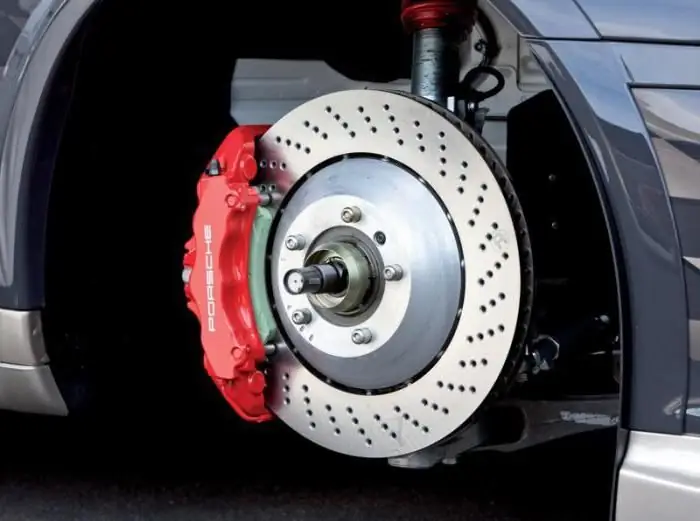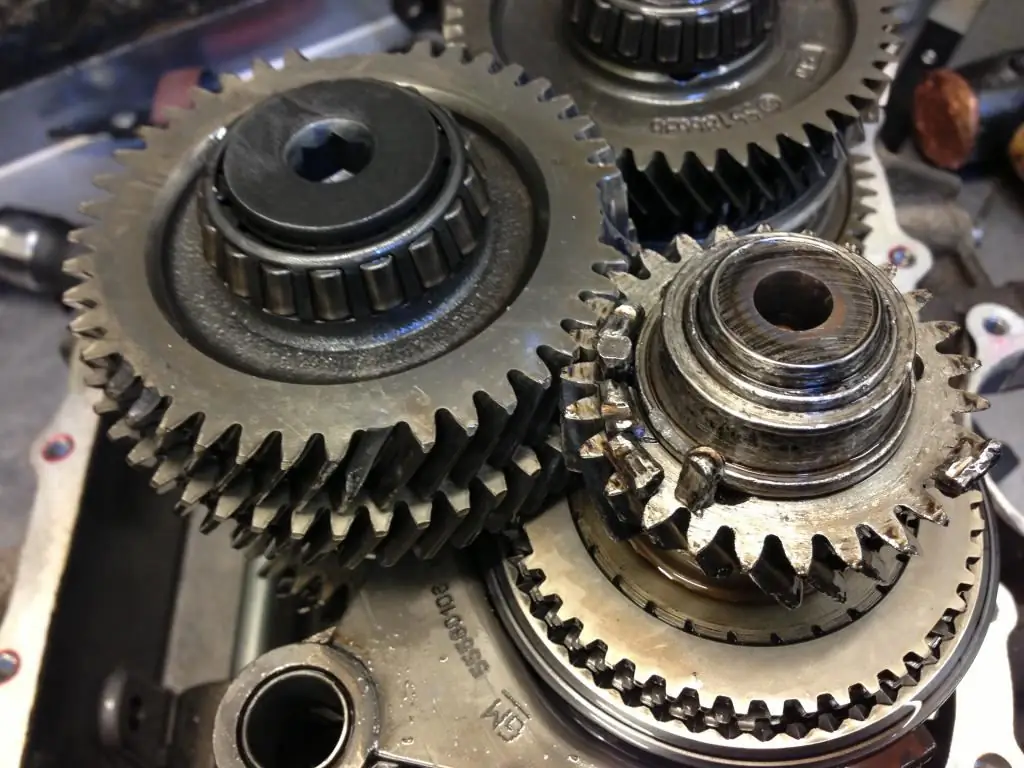2026 Author: Erin Ralphs | [email protected]. Last modified: 2025-01-22 21:14:09
Automotive braking system belongs to the active protection device. The principle of operation is to change the speed of vehicles. Including the system is designed to completely stop the car, including an emergency stop, as well as keeping vehicles in place while parking on slopes. Various systems are used to achieve these goals. Brake is the main one. In addition to it, an additional spare and parking system is also used. On modern cars, an auxiliary system and anti-lock braking are also used. How is the brake system designed and operated? What are its types? The device, purpose and principle of operation of the brake system is described in the article.
Description of working system
How does it work? The principle of operation of the braking system of a car is to change its speed and stop it completely (including in emergency cases to avoid accidents). The system consists of a drive and braking mechanisms. Different vehicles have different types of systems. It is hydraulic and pneumatic.

Description of hydraulic system
The principle of operation of the hydraulic brake system is the action of the pedal on the pads using fluid or hydraulics. It consists of the following components:
- main hydraulic cylinder;
- vacuum amplification unit;
- ABS or wheel lock control system;
- rear disc pressure control module;
- main brake cylinders;
- hydraulic circuit.
Main hydraulic cylinder
It is used to transmit the force that the driver communicates to the brake pedal. This force is transferred to the hydraulic circuit. Further, the energy is distributed among the disks.

Vacuum amplification assembly
Supplements the work of the hydraulic cylinder. Designed to enhance the effect of transferring pedal power to braking mechanisms.
Rear Disc Pressure Control Module
What is it for? The module monitors the force of pressure on the rear discs. Due to this, the smoothest braking during the trip is achieved. Actively used without ABS. With it, this system becomes secondary.
Wheel lock monitoring system
Not installed on all vehicles. Its purpose is to track the moments of complete wheel lock. This is done intentionally so that the vehicle does not skid. This is important on slippery and wet roads when the car starts to skid and become uncontrollable during braking.
Hydraulic circuit
It is a network of interconnected pipelines with fluid or hydraulics. The circuit connects the main and brake cylinders. They transmit the force of pressing the pedal to the cylinders. The contours can perform the functions of each other. And sometimes they can carry out their main functions. The system of double crossing of contours for brake drives is most demanded. It is arranged diagonally.
Description of pneumatic system
The principle of operation of the pneumatic brake system is basically the same as the hydraulic one. It includes an air compressor, which, driven by the engine, pumps atmospheric air into the cylinders. The controller maintains the pressure specified by the parameters.

Air for braking is stored in special cylinders or receivers. As it exits the circuit, it is pumped in additionally by a compressor. When the driver presses the pedal, the air from the receivers or cylinders passes along the contour into the brake modules. The latter have special rods that already actuate the braking mechanisms. The pads are pressed against the disks (drums) of the wheels. Due to this, the transport begins to slow down and gradually stop. After the driver releases the pedal, the air from the system comes back out, and the cycle repeats. Springsreturn the stems to their original position.
Basically, this is the principle of operation of the KamAZ brake system. Such a system is often used on trucks due to its efficiency. While the hydraulics need to be checked and topped up, the air system requires less attention and also doesn't need constant topping up.
Air compressor
Located in the car's engine, it pumps air from the atmosphere into the pneumatic system. The compressor only runs when the engine is running. As soon as the nominal pressure in the system decreases, it starts up and brings it to the desired value. The principle of operation of the air system is based on the compressor. The safety of passengers and the safety of the transport itself depend on the serviceability of this unit.
Pressure control system
This system controls the nominal pressure in circuits and cylinders. It vents excess air back into the atmosphere. It also controls the operation of the compressor, that is, it gives commands when to start pumping air and when to stop.

Air dehumidification system
In order for the condensate coming along with atmospheric air not to accumulate in the braking system, it is necessary to dry the air. The main purpose of the system is to prevent or minimize the ingress of moisture. This is especially important in winter. If condensation forms, it can simply freeze in winter and minimize the effect of the brakes.
Receivers
What are receivers in a car for? Their purpose is to accumulate the air necessary for braking. When the drop is pressed, air is taken from the receivers and goes into the circuit.
Chambers for braking
Air from the circuits enters the chambers. The latter already convert their pressure into a mechanical force of pressure on the pads by means of rods.
Manual brake valve
The purpose is the same as that of the parking brake - to keep the car motionless while parking. Instead of cables, pneumatics are used here. There are also energy batteries. They perform the function of braking during parking, as well as in the event of a critical drop in air pressure in the pneumatic system.
Manometer
Means of pressure control in the braking system. Located on the dashboard. The driver can control the air pressure.

Emergency alarms are designed to warn the driver of a critical pressure drop in the chambers.
Auxiliary braking system
We continue to study the device and the principle of operation of the brake system. An additional system is designed for emergency and emergency cases. In fact, it duplicates the main system. It works in cases when the main brakes are faulty. The system can work independently, or it can complement the work of the main one.
Parking brake system
What is its essence? The principle of operation of the brake system is to press the pads to the discs during parkingtransport. Its purpose is:
- keep the vehicle stationary while parked;
- Prevention of self-driving car on slopes;
- emergency duplication of the main and auxiliary systems.
The device of the car braking system
The composition includes certain mechanisms and drives connected to them. The whole principle of the brake system is based on their clear interaction with each other.
The braking mechanism itself is needed to generate the forces needed to stop or slow down the vehicle. The element is mounted on the wheel hub and works by friction. The braking mechanism is either disc or drum. The first option is used much more often now.
The brake system includes static and rotating mechanisms. The drums are static, and the pads with special overlays rotate. The disc version has a rotating brake disc and a fixed caliper element with pads. These mechanisms are controlled by special drives.
In the brake system, hydraulics are not actually the only system. So, for parking, traction levers and metal cables are used. By means of cables, the rear wheel pads are connected to the lever in the cab. In addition to hydraulics and mechanics, electric drives are also used to control the process of braking and stopping the car.

The hydraulic system can be supplementedby other means. These are wheel lock protection, directional stability aids, emergency braking assistance, and an emergency speed reduction assistance system.
In addition to hydraulics, pneumatic and electrical systems are used. There is a combined type of brakes. This is a pneumohydraulic one, which was previously used on ZIL "Bychok" trucks (at the moment these cars are not produced).
Working principle
The principle of operation of the brake system is as follows:
- By pressing the pedal, the driver generates some force, which is transmitted to the vacuum unit.
- The force of pressing the pedal increases in the vacuum unit and is already transmitted to the master cylinder.
- The piston of the cylinder acts on the hydraulics and pushes it along the contour of the pipelines. The pressure in the circuit begins to rise, the fluid presses on the pistons of the brake cylinders. Those, in turn, press the pads against the discs.
- Increasing pedal pressure increases hydraulic pressure. Due to the increase in pressure, braking mechanisms begin to work. The stronger the fluid pressure, the more efficient the system.
- Releasing the pressure on the pedal returns all mechanisms to their original position due to a special spring.

Conclusion
The article considered the device and the principle of operation of the car's brake system. In general, this system is designed to ensure the safety of vehicular traffic, so it should be given special attention.attention.
Recommended:
ABS system. Anti-blocking system: purpose, device, principle of operation. Bleeding brakes with ABS

Not always an inexperienced driver manages to cope with the car and quickly reduce the speed. You can prevent skidding and blocking of the wheels by intermittently applying the brake. There is also an ABS system, which is designed to prevent dangerous situations while driving. It improves the quality of grip with the roadway and maintains the controllability of the car, regardless of the type of surface
The principle of operation of the variator. Variator: device and principle of operation

The beginning of the creation of variable programs was laid in the last century. Even then, a Dutch engineer mounted it on a vehicle. After such mechanisms were used on industrial machines
"Lada-Kalina": ignition switch. Device, principle of operation, installation rules, ignition system, advantages, disadvantages and features of operation

Detailed story about the ignition switch Lada Kalina. General information and some technical characteristics are given. The device of the lock and the most frequent malfunctions are considered. The procedure for replacing with your own hands is described
Car engine cooling system: device and principle of operation

The engine cooling system in the car is designed to protect the working unit from overheating and thereby controls the performance of the entire engine block. Cooling is the most important function in the operation of an internal combustion engine
Planetary gearbox: device, principle of operation, operation and repair

Planetary gears are among the most complex gear boxes. With a small size, the design is characterized by high functionality, which explains its widespread use in technological machines, bicycles and caterpillar vehicles. To date, the planetary gearbox has several design versions, but the basic principles of operation of its modifications remain the same

